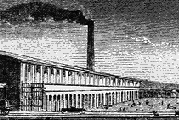|
We have surveyed several of the important phases in the history of optimal growth theory, from its beginnings in the work of Ramsey, through the Golden Rule, through the painstaking ethical acrobatics of constructing intertemporal social welfare functions, through to the Cass-Koopmans construction, the revelation of the turnpike and, finally, the "decentralization" thesis. It was a necessarily superficial survey, and we hope you proceed to our references for a fuller account. We nonetheless feel that we have at least touched upon most of the major issues in the field. We have been neglectful in one significant respect: namely, we have deliberately avoided touching on more recent developments in optimal growth theory, such as the rise of "Real Business Cycle" theory and "New Growth Theory" in the 1980s. We did so because we believe the interpretation and purpose of these latter constructions are so distinct from those of the original theory that they deserve an entirely separate treatment. However, we cannot end our discussion of optimal growth theory without at least some final reflections on this metamorphosis. Optimal growth theory has changed more than we have indicated here. The "Real Business Cycle" research program, initiated in the early 1980s by Finn Kydland, Edward Prescott, Robert King and Sergio Rebelo, took Neoclassical growth theory -- and optimal growth theory in particular -- as its basic underlying model. It heavily and unabashedly relies upon the "decentralization thesis" for methodological justification. It prides itself in its tremendous efforts to "calibrate" the ghostly parameters of the Cass-Koopmans model -- time preference, utility functions, productivity, etc. -- so that the optimal solution path of this normative model is matched to the actual empirical data of economies around the world. Empirical accounts of growth and fluctuations of output, employment and growth are regarded as the optimal paths derived as solutions to appropriately-calibrated optimal growth models. Today, optimal growth theory and other variations on the Ramsey exercise are marketed as actual representations of how the economy works -- despite the fact that reality tells us the social planner does not exist. And if we insist on interpreting him as a "representative agent", then we must keep in mind that microeconomic theory (specifically, the Sonnenschein-Mantel-Debreu theorem), tells us that he would misbehave. But, for some mystifying reason, modern economics persists with this fiction, despite the overwhelming theory and evidence against it. Appealing to "representative agents" is a deplorable, but sadly common and ancient habit in economics. There are more paradoxes that could be drawn out of this -- which ought to be particularly delicious for Austrian School economists. For instance, the decentralization thesis basically argues that the centralized economy of (a benevolent) Stalin "represents" or "achieves the same solution as" the decentralized economy of wild capitalist markets. The credibility of this assertion is worth contemplating for a moment or two, particularly in light of the Socialist Calculation debates of the 1930s. One may also wish to reflect upon the meaning of "prices" in such an economy. One of the remarkable justifications put forth for the use of an infinitely-lived, perfect foresight, representative agent in modern modeling is that agent heterogeneity, imperfect foresight, etc. would make the "optimal solutions" indeterminate. Put another way, modern theorists can only derive equilibrium prices when there are no incentives for exchange among agents; but when such an incentive exists, they cannot obtain equilibrium prices! A naughty wag could certainly get a lot of mileage out of that. As this survey should make evident, this transformation in motivation for and application of optimal growth theory is one which the original constructors would find surprising, if not appalling. Frank Ramsey certainly conceived of his contribution more as an exercise in Benthamite utilitarian philosophy than in descriptive economics. At any rate, recall that his main point was to demonstrate that the market solution would be suboptimal. The early builders of the 1960s -- Tinbergen, Goodwin, Koopmans and others -- were eager to put it to good use in development planning, perhaps naively believing that the ought of optimal growth theory could be deliberately planned into becoming an is, after all. As late as mid-1970s, Tjalling Koopmans was still arguing that the principal clientèle of optimal growth theory should be "policy economists who may find it useful to have the more abstract ideas of this field in the back of their mind when coping with the day-to-day pressures for outcomes rather than criteria." (Koopmans, 1977). One of the classics of optimal growth theory, the famous treatise of Kenneth J. Arrow and Mordecai Kurz (1970) was written almost as a handbook for policy economists. The interface between government policy and optimal growth was also explored by other pioneering spirits, such as Hirofumi Uzawa (1969) and Edmund S. Phelps (1974). The conclusion of Tjalling Koopmans's Nobel lecture captures the spirit behind the original construction of optimal growth theory:
As such, for those interested in the sociology of doctrines, optimal growth theory turns out to be quite a curiosity. It was drastically transformed in the 1980s from a normative theory to a positive theory, from a theory which sought to find out what ought to be, to one which claims to discern what is. This has almost no parallel in the history of economic theory. It is striking in at least two respects. Firstly, this metamorphosis managed to do something that seems to be quite unprecedented: instead of falling into the classical fallacy of "deriving an ought from an is", as David Hume famously warned against, they actually managed to fall into the reverse fallacy of "deriving an is from an ought". Secondly, optimal growth theory has magically moved from one end of the ideological spectrum to almost the exact opposite -- the planning tool of the dirigiste economist has become the bible of the Panglossian.
|
All rights reserved, Gonšalo L. Fonseca

